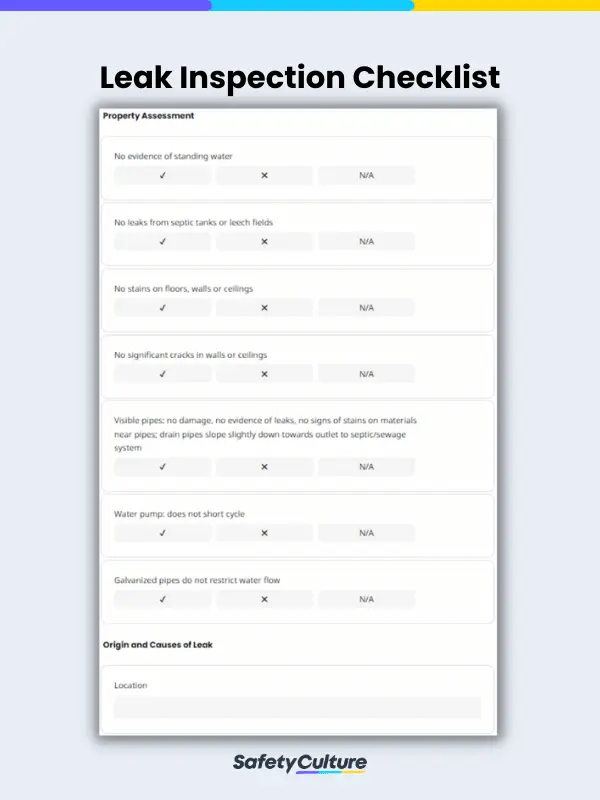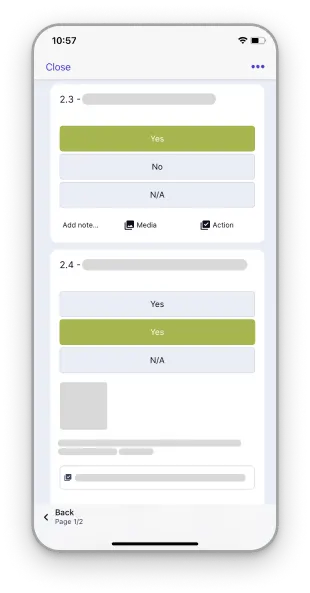What is a Leak Inspection?
A leak inspection is the process of checking pipeline systems to detect the existence of water, oil, or gas leakage. The goal is to identify the origin and causes of leaks to come up with an appropriate or corrective action or remediation. Leak inspections are performed by a certified plumber to assess the property and identify traces of leak damage. Failure to conduct leak inspections can cause inefficiencies, undetected problem spots, repetitive work, property damages, and costly repairs or replacements.
What is a Leak Inspection Report?
A water leak inspection report is a document used to track and report water leaks within a facility and its equipment. Having such a report can help with the following:
- Identifying the source and extent of the leak
- Tracking maintenance and repair needs for the leak detection system
- Describing and collecting the details of the leak and any corrective actions taken
Benefits
Leaks of any form can cause serious and costly problems. As they can occur in many places in a building, such as around a toilet, under a sink, behind a refrigerator, or in the basement, they can cause extensive damage to a building and its contents. Subsequently, they can also be a safety hazard, as they can lead to the growth of mold and bacteria.
A leak inspection report can help identify leaks before they become bigger problems. It can also help with system maintenance and identify any potential problems with the leak detection system before or as they happen. It is important to conduct regular leak inspections and have a leak report template in place to document any leaks that are found.
What Should a Leak Inspection Form Cover?
A leak inspection report should cover the following:
- Date and time of inspection
- Location of leak
- Inspector or plumber in-charge
- Other observations that may be relevant to the inspection
- Diagram or photo of the leak, if applicable
How Technology Can Help Effectively Perform Leak Inspections
Failure to locate elusive leaks can lead to flooding, destruction of property structures, and high damage costs. An effective leak inspection can help detect leaks in its early stages and prevent significant water damage by implementing immediate solutions. Here’s a step-by-step guide on how you can use technology like SafetyCulture (formerly iAuditor), the world’s most powerful inspection app, to help you effectively perform leak inspections:
Assess the property
Interview the person in charge to get the detailed structure of the property. Check indicators like a fast meter, a sudden spike in the water bill, and unusual dripping sounds. Do a physical check of pipelines and identify visible traces of potential structural issues and damages.
Detect the origin of leaks and secure the area
There are various methods of leak detection depending on the type of leakage. For example, when there is water leakage, you can use sonic leak-detection equipment to locate the sound of water dripping from the pipe. For gas leakage, use helium-leak detectors that use mass spectrometry.
After detecting the source of the leak, secure the area and immediately shut off the valve connected to the damaged pipes. This will help control the leak and related hazards.
Identify the cause of leaks
The most common causes of leaks are broken seals, clogged lines, corrosion, and damaged pipe joints. Identifying traces of possible leakage can help prevent bigger damage.
Estimate the timeline of repair
Pipeline repair, depending on the extent of damages, can substantially affect workplace production. A timeline of repair would help in planning out alternative solutions and corrective actions so as not to hinder workplace production.
Document progress and share real-time reports
Proper documentation of key tasks is necessary to monitor the progress of repairs. It will help other teams process and evaluate the job being done.



